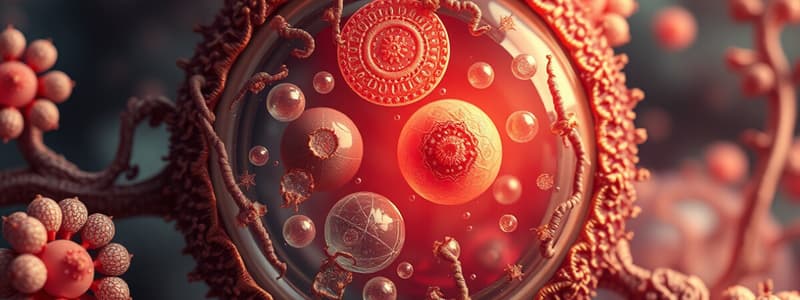Podcast
Questions and Answers
What is the fluid between the cell membrane and the nucleus called?
What is the fluid between the cell membrane and the nucleus called?
- Cytoplasm (correct)
- Nucleus
- Ribosome
- Endoplasmic Reticulum
What is the role of the nucleus in a cell?
What is the role of the nucleus in a cell?
It contains hereditary information and is responsible for growth and reproduction.
What do ribosomes do?
What do ribosomes do?
They make proteins.
What is the function of the endoplasmic reticulum?
What is the function of the endoplasmic reticulum?
What does the Golgi apparatus do?
What does the Golgi apparatus do?
What are lysosomes responsible for?
What are lysosomes responsible for?
What is the function of a vacuole?
What is the function of a vacuole?
What does mitochondrion generate?
What does mitochondrion generate?
What is the role of chloroplasts?
What is the role of chloroplasts?
What is the function of the cytoskeleton?
What is the function of the cytoskeleton?
What are cilia?
What are cilia?
What is the role of a flagellum?
What is the role of a flagellum?
What is the function of the cell membrane?
What is the function of the cell membrane?
What is the purpose of the cell wall?
What is the purpose of the cell wall?
What is the role of centrioles?
What is the role of centrioles?
Flashcards are hidden until you start studying
Study Notes
Cell Organelles and their Functions
-
Cytoplasm: Fluid that serves as a medium between the cell membrane and nucleus, providing protection for organelles.
-
Nucleus: Contains hereditary information, overseeing cell growth and reproduction; referred to as the cell’s "command center."
-
Ribosome: Small particles within the cell responsible for synthesizing proteins.
-
Endoplasmic Reticulum (ER): Complex network of membranes acting as passageways for transporting proteins and materials within the cell.
-
Golgi Apparatus: Structure responsible for modifying, packaging, and transporting materials, either out of the cell or for internal storage.
-
Lysosome: Enzyme-filled organelle crucial for breaking down cellular waste and large particles; primarily found in animal cells.
-
Vacuole: Sac-like structure used for storing water, nutrients, and waste; plays a role in maintaining cell turgor.
-
Mitochondrion: Known as the powerhouse of the cell, it contains enzymes that play a key role in energy production through metabolism and respiration.
-
Chloroplast: Organelle in plant cells (and some other organisms) that captures sunlight for photosynthesis, converting it into chemical energy.
-
Cytoskeleton: Network of protein filaments that provides structural support, helping maintain cell shape and enabling movement.
-
Cilia: Hair-like structures on the cell surface that assist in movement and fluid transport across cell surfaces.
-
Flagellum: Single whip-like projection that facilitates cell mobility.
-
Cell Membrane: Semi-permeable barrier surrounding the cell, controlling the entry and exit of substances.
-
Cell Wall: Rigid outer layer providing support and protection, found in plants, algae, fungi, and some bacteria.
-
Centriole: Animal cell structure involved in organizing and orchestrating cell division.
Studying That Suits You
Use AI to generate personalized quizzes and flashcards to suit your learning preferences.




